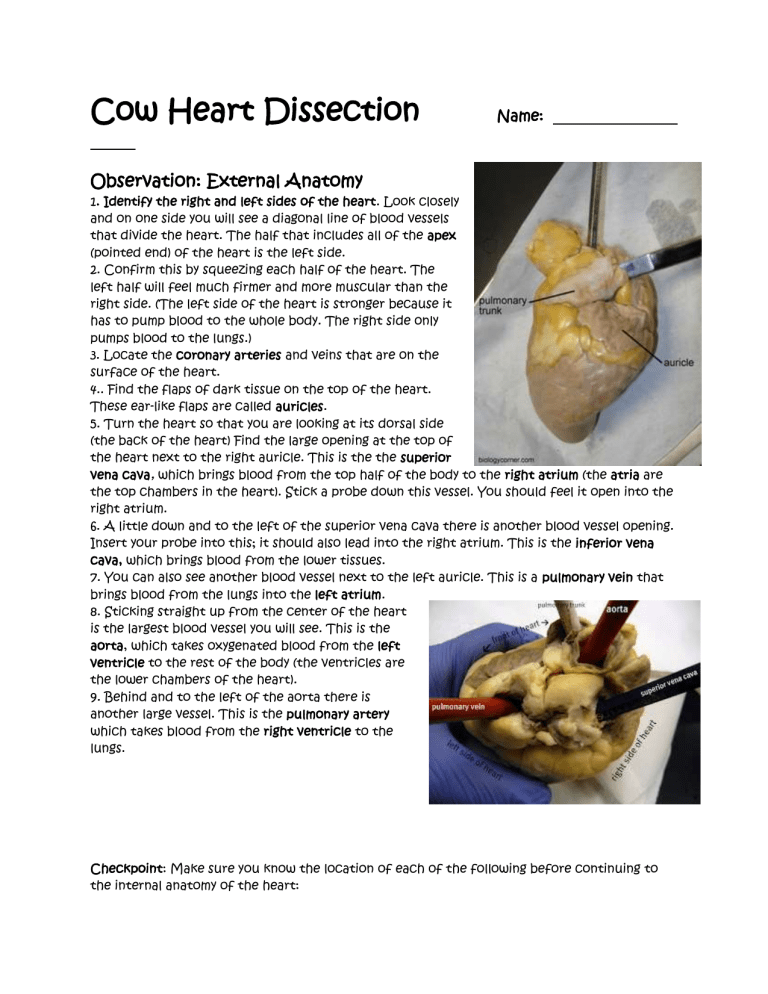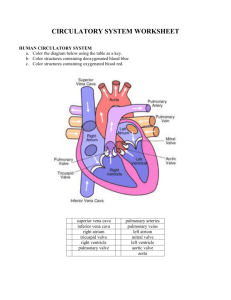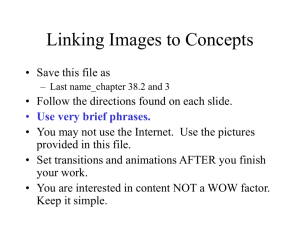Cow Heart Dissection

Cow Heart Dissection
Name:
Observation: External Anatomy
1. Identify the right and left sides of the heart. Look closely and on one side you will see a diagonal line of blood vessels that divide the heart. The half that includes all of the apex
(pointed end) of the heart is the left side.
2. Confirm this by squeezing each half of the heart. The left half will feel much firmer and more muscular than the right side. (The left side of the heart is stronger because it has to pump blood to the whole body. The right side only pumps blood to the lungs.)
3. Locate the coronary arteries and veins that are on the surface of the heart.
4.. Find the flaps of dark tissue on the top of the heart.
These ear-like flaps are called auricles.
5. Turn the heart so that you are looking at its dorsal side
(the back of the heart) Find the large opening at the top of the heart next to the right auricle. This is the the superior vena cava , which brings blood from the top half of the body to the right atrium (the atria are the top chambers in the heart). Stick a probe down this vessel. You should feel it open into the right atrium.
6. A little down and to the left of the superior vena cava there is another blood vessel opening.
Insert your probe into this; it should also lead into the right atrium. This is the inferior vena cava, which brings blood from the lower tissues.
7. You can also see another blood vessel next to the left auricle. This is a pulmonary vein that brings blood from the lungs into the left atrium.
8. Sticking straight up from the center of the heart is the largest blood vessel you will see. This is the aorta, which takes oxygenated blood from the left ventricle to the rest of the body (the ventricles are the lower chambers of the heart).
9. Behind and to the left of the aorta there is another large vessel. This is the pulmonary artery which takes blood from the right ventricle to the lungs.
Checkpoint: Make sure you know the location of each of the following before continuing to the internal anatomy of the heart:
superior vena cava pulmonary artery pulmonary veins left atrium & ventricle right atrium and ventricle auricle inferior vena cava apex aorta coronary arteries & veins
Dissection: Internal Anatomy
1. Insert your dissecting scissors or scalpel into the superior vena cava and make an incision down through the wall of the right atrium and ventricle, as shown by the arrow in the external heart picture. Pull the two sides apart and look for three flaps of membrane. These membranes form the tricuspid valve between the right atrium and the right ventricle.
2. The valves are connected to the papillary muscles by tendons called the chordae tendinae or "heartstrings."
Locate these structures.
3. Insert your probe into the pulmonary artery and see it come through to the right ventricle. Make an incision down through this artery and look inside it for three small membranous pockets. These form the pulmonary semilunar valve which prevents blood from flowing back into the right ventricle.
4. Make an incision down through the wall of the left atrium and ventricle, as shown by the arrow. Locate the mitral valve (or bicuspid valve) between the left atrium and ventricle. You can also find the papillary muscles and the chordae tendinae on this side of the heart.
5. Insert a probe into the aorta and observe where it connects to the left ventricle. Make an incision up through the aorta and examine the inside carefully for three small membranous pockets. These form the aortic semilunar valve
Analysis Questions
1. What muscles hold the valves in place?
2. What is another name for the bicuspid valve?
3. What are the flaps on the front of the atria called?
4. If you place a probe in the aorta, into what chamber will it exit?
5. The superior and inferior vena cava enter into what chamber of the heart?
6. What are the tendons that connect the valves to the muscles?
7. What is the only artery in the body that carries deoxygenated blood?




